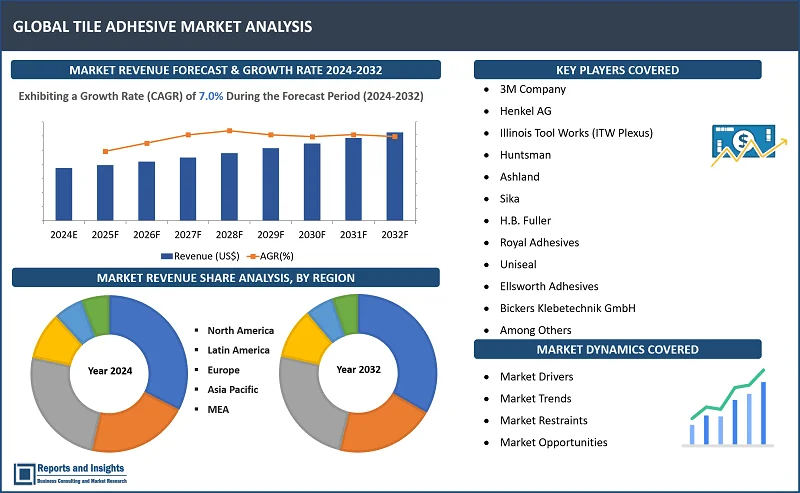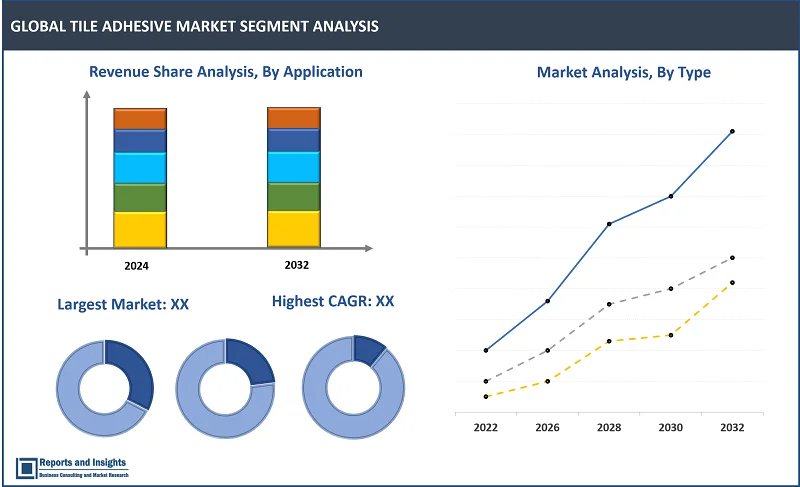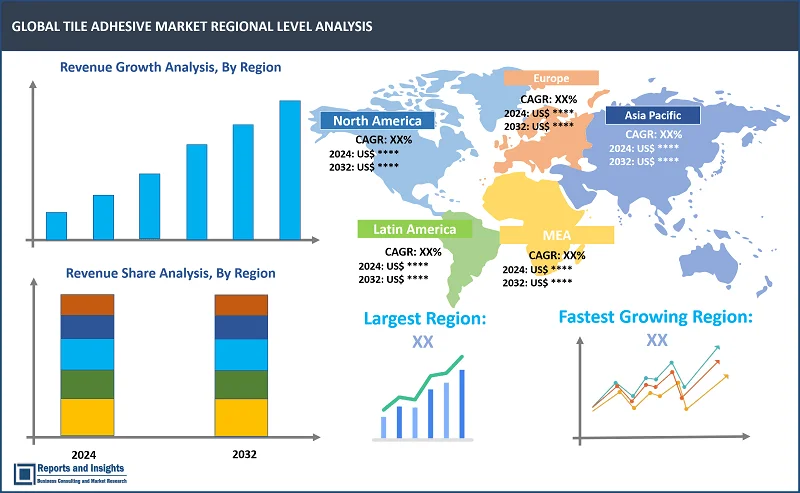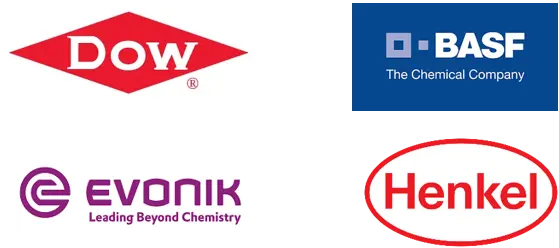Market Overview:
"The global tile adhesive market was valued at US$ 2.4 Billion in 2023, and is expected to register a CAGR of 7.0% over the forecast period and reach US$ 4.4 Bn in 2032."
|
Report Attributes |
Details |
|
Base Year |
2023 |
|
Forecast Years |
2024-2032 |
|
Historical Years |
2021-2023 |
|
Tile Adhesive Market Growth Rate (2024-2032) |
7.0% |
Tile adhesives used as crucial constituents in the construction sector, acting as bonding agents for securing tiles to different substrates. These adhesives offer several advantages over the conventional cementitious approaches, comprising improved adhesion, quicker installation, and decreased curing times. The global market for tile adhesives is experiencing persistent growth, impelled by growing construction activities, urbanization, and infrastructure development across the world. Factors such as breakthroughs in adhesive technology, soaring demand for high-performance products, and the transition towards sustainable and eco-friendly solutions are further accelerating market expansion. In addition, the increasing trend toward aesthetic tiling solutions in residential and commercial projects is propelling demand for tile adhesives. Leading players in the market are emphasizing on product innovations, strategic partnerships, and geographical extensions to gain a competitive advantage. As construction activities continue to soar worldwide, the tile adhesive market is anticipating for continued growth in the forthcoming years.
In recent years, the tile adhesive market has witnessed swift advent of advanced adhesive formulations designed to improve flexibility, bonding strength, and resistance to environmental factors. Manufacturers are progressively accentuating on developing environment-friendly and sustainable adhesive solutions to address increasing environmental concerns. Along with that, there has been a remarkable surge in the adoption of innovative tile adhesive systems capable of bonding different kinds of tiles to various surfaces, catering to the developing needs of construction projects. Moreover, mergers, strategic collaborations, and acquisitions among industry players have redefined the competitive outlook, resulting in the expansion of product portfolios and market reach. These developments highlight the dynamic nature of the global tile adhesives market, which persists in evolving in response to varying industry trends and demands for superior performance and sustainability.

Tile Adhesive Market Trends and Drivers:
Urbanization and the subsequent rise in construction activities, specifically in emerging economies, hold an essential role in boosting demand for tile adhesives. In addition, the soaring trend towards renovation and remodeling projects, especially in the residential sector, further spurs market growth.
Technological innovations have paved its way to the rapid development of high-performance tile adhesives that offer superior bonding strength, flexibility, and durability, propelling their adoption in different construction applications. Alongside this, the switch towards sustainable building materials has encouraged manufacturers to innovate eco-friendly tile adhesive solutions, catering to the growing demand for environmentally conscious construction practices. The increasing preference for aesthetically pleasing tiling solutions in both residential and commercial spaces also contributes to market expansion.
Tile Adhesive Market Restraining Factors:
One notable challenge is the high transportation costs related to construction chemicals, including tile adhesives. These products are oftentimes heavy and bulky, which leads to higher shipping expenses, which can eventually impact the overall cost-effectiveness of construction projects. In addition, fluctuations in raw material prices, specifically petroleum-based ingredients typically used in adhesive formulations, can contribute to market uncertainty and volatility. Moreover, stringent regulations regarding the use of certain chemical compounds in adhesive formulations, particularly volatile organic compounds (VOCs), present compliance challenges for manufacturers. Additionally, economic fluctuations and downturns in construction activity levels in crucial markets can also impede market growth.
Tile Adhesive Market Opportunities:
Civic infrastructure development is swiftly advancing across different countries, creating a significant demand for construction materials such as tile adhesives. Governments in developing nations, like India, are actively facilitating initiatives to reinforce their construction sectors, thus stirring market growth. Other than that, the expanding interest towards urbanization and the rapid development of smart cities across the globe further fuels the demand for superior-quality construction materials, including tile adhesives, for infrastructure projects.
Besides, the booming trend towards sustainable building practices and green construction further serve opportunities for manufacturers to innovate environment-friendly adhesive solutions, streamlining with evolving environmental regulations and consumer preferences. In addition, breakthroughs in adhesive technology, such as enhanced formulations for improved performance and durability, unveil possibilities for market players to capitalize on evolving trends and cater to the emerging needs of the construction industry.
Tile Adhesive Market Segmentation:

By Type
- Cementitious
- Dispersion
- Reaction Resin
The cementitious segment accounts for the majority of the market share in 2023 and is projected to maintain its dominant position during the forecast period. This is primarily attributed to the surge in the number of residential and large-scale construction projects that are accelerating the usage of tiles. However, dispersion is the fastest-growing category over the forthcoming period. The capability of dispersion to deliver chemical resistance and support in strengthening the durability of the finished product. Dispersion-based tile adhesives utilize less water and have higher flexural strength than cement-based tile adhesives, making them appealing options.
By Application
- Wall Tile
- Floor Tile
- Ceiling Tile
- Indoor Tile
- Outdoor Tile
- Swimming Pool Tile
- Others
The floor tile segment witnesses escalating demand in the global tile adhesives market as floor tiles are extensively used in residential, commercial, and industrial spaces, fuelling consistent demand for tile adhesives. In addition, the aesthetic appeal, durability, and ease of maintenance associated with floor tiles further contribute to their high market share.
By End User
- Residential
- Commercial
- Industrial
- Others
The residential segment holds the largest share in the end-user segment of the global tile adhesives market owing to numerous crucial factors. With growing urbanization and construction of residential properties, there is a surging demand for tile adhesives for different applications such as flooring, walls, and ceilings. In addition, renovation and remodelling activities in the residential sector further boost the consumption of tile adhesives.
By Technology
- Water-based Adhesives
- Solvent-based Adhesives
- Hot-Melt based Adhesives
The water-based adhesives segment holds the largest share in the technology segment of the global tile adhesives market. This is chiefly owing to the growing environmental concerns and regulations favoring environment-friendly construction materials. Water-based adhesives provide lesser VOC emissions, enhanced safety, and better cleanup, making them a appealing choice for both manufacturers and end-users seeking sustainable and efficient solutions in construction projects.
By Region

North America
- United States
- Canada
Europe
- Germany
- United Kingdom
- France
- Italy
- Spain
- Russia
- Poland
- Benelux
- Nordic
- Rest of Europe
Asia Pacific
- China
- Japan
- India
- South Korea
- ASEAN
- Australia & New Zealand
- Rest of Asia Pacific
Latin America
- Brazil
- Mexico
- Argentina
Middle East & Africa
- Saudi Arabia
- South Africa
- United Arab Emirates
- Israel
- Rest of MEA
The global tile adhesive market is divided into five key regions: North America, Europe, Asia Pacific, Latin America, and the Middle East and Africa. North America dominates the global tile adhesives market owing to several prominent factors. Primarily, robust construction activities in residential, commercial, and infrastructure sectors across the United States and Canada fuel significant demand for tile adhesives. Additionally, stringent regulations focusing on the usage of high-quality and eco-friendly construction materials further spur market growth. Other than that, technological progresses, such as the development of innovative adhesive formulations, contribute to the region's market dominance. Furthermore, the presence of leading market players and investments in research and development activities also improve North America's position as a leader in the global tile adhesives market.
Leading Key Players in Tile Adhesive Market & Competitive Landscape:
The competitive landscape of the global tile adhesives market is marked by the presence of numerous prominent players striving to maintain their market positions through different strategies. Key players emphasize on product innovation to develop advanced adhesive formulations that provide superior performance and address specific customer needs. In addition, strategic collaborations, mergers, and acquisitions are common strategies employed by prominent companies to expand their product portfolios, improve market presence, and gain a competitive advantage. Along with that, investments in research and development, coupled with geographical expansions, are vital for sustaining growth and competitiveness in the dynamic tile adhesives market.
These companies include:
- 3M Company
- Henkel AG
- Illinois Tool Works (ITW Plexus)
- Huntsman
- Ashland
- Sika
- H.B. Fuller
- Royal Adhesives
- Uniseal
- Ellsworth Adhesives
- Bickers Klebetechnik GmbH
- wedi GmbH
- 1a Bauchemie GmbH
- AB BECHCICKI Sp
- Akzo Nobel Deco GmbH
Recent Developments:
- In January 2024, Magma, a B2B manufacturing and supply chain enablement platform for building materials, has announced its expansion into the adhesive market with the launch of MagFix. This strategic initiative aims to enhance its portfolio and provide comprehensive solutions to manufacturers, complementing its existing offerings.
- In April 2024, Pidilite Industries Ltd. (Pidilite) inaugurated a new manufacturing facility in Sandila, near Lucknow, India, for its tile adhesive brand, Roff. The fully automated facility, spanning an expansive 11,000 square meters, is set to enhance the Roff footprint in North India. According to Pidilite, the facility is the first of its kind manufacturing unit of any branded tile adhesive in this region and has been built to adhere to global standards of manufacturing excellence.
- In September 2023, Hindware Limited announced its foray into Tile Adhesive industry and expansion of its product offerings in the tiles category. The brand has launched 5 different SKUs in adhesives to cater to the entire tile category, ranging from ceramic to elevation tiles. With this strategic move, the brand aims to provide customers with a comprehensive solution for their construction and home improvement needs under one roof.
Tile Adhesive Market Research Scope
|
Report Metric |
Report Details |
|
Tile Adhesive Market size available for the years |
2021-2023 |
|
Base Year |
2023 |
|
Forecast Period |
2024-2032 |
|
Compound Annual Growth Rate (CAGR) |
7.0% |
|
Segment covered |
Type, Application, End User, Technology |
|
Regions Covered |
North America: The U.S. & Canada Latin America: Brazil, Mexico, Argentina, & Rest of Latin America Asia Pacific: China, India, Japan, Australia & New Zealand, ASEAN, & Rest of Asia Pacific Europe: Germany, The U.K., France, Spain, Italy, Russia, Poland, BENELUX, NORDIC, & Rest of Europe The Middle East & Africa: Saudi Arabia, United Arab Emirates, South Africa, Egypt, Israel, and Rest of MEA |
|
Fastest Growing Country in Europe |
Germany |
|
Largest Market |
North America |
|
Key Players |
3M Company, Henkel AG, Illinois Tool Works (ITW Plexus), Huntsman, Ashland, Sika, H.B. Fuller, Royal Adhesives, Uniseal, Ellsworth Adhesives, Bickers Klebetechnik GmbH, wedi GmbH, 1a Bauchemie GmbH, AB BECHCICKI Sp, Akzo Nobel Deco GmbH, among others |
Frequently Asked Question
What is the market size of the tile adhesive market in 2023?
The tile adhesive market size reached US$ 2.4 Billion in 2023.
At what CAGR will the tile adhesive market expand?
The market is expected to register a 7.0% CAGR through 2024-2032.
Which country is expected to account for the largest revenue contribution to the Europe tile adhesives market?
Germany is expected to account for largest revenue share contribution to the Europe tile adhesives market
What are some key factors driving revenue growth of the tile adhesive market?
Some key factors driving revenue growth are urbanization and the subsequent rise in construction activities among others.
What are some major challenges faced by adopters of tile adhesive manufacturers?
Some key challenges include high transportation costs related to construction chemicals, including tile adhesives.
How is the competitive landscape in the tile adhesive market?
The competitive landscape in the Tile Adhesive market is dynamic with focus on product innovation to develop advanced adhesive formulations that provide superior performance and address specific customer needs.
How is the tile adhesive market segmented?
The market report is segmented based on type, application, end user, technology, and region.
Which top companies are included in the global tile adhesive market report?
3M Company, Henkel AG, Illinois Tool Works (ITW Plexus), Huntsman, Ashland, Sika, H.B. Fuller, Royal Adhesives, Uniseal, Ellsworth Adhesives, Bickers Klebetechnik GmbH, wedi GmbH, 1a Bauchemie GmbH, AB BECHCICKI Sp, Akzo Nobel Deco GmbH, among others.

